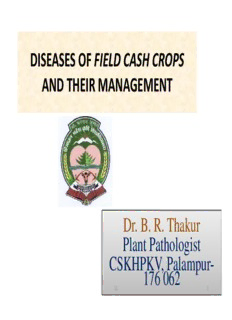
DISEASES OF FIELD CASH CROPS AND THEIR MANAGEMENT PDF
Preview DISEASES OF FIELD CASH CROPS AND THEIR MANAGEMENT
DISEASES OF FIELD CASH CROPS AND THEIR MANAGEMENT Dr. B. R. Thakur Plant Pathologist CSKHPKV, Palampur- 176 062 11 1 DISEASES OF SUGARCANE (SACCHARUM OFFICINARUM) • Red rot- Colletotrichum falcatum( or Glomerella tucumanensis) • Smut-Ustilago scitaminea • Grassy shoot-Phytoplasma • Ratoon stunting-Clavibacter xyli pv. xyli (Xylem limited fastidious bacteria) Red Rot of Sugarcane DISEASE: Red Rot PATHOGEN: Colletot richum falcatum (Glomerella tucumanensis) HOSTS: Sugarcane 3 Symptoms and Signs Red rot is usually considered as a stalk and a seed-piece disease. Leaf Symptoms • Tiny reddish lesions on the upper surface of the lamina. • Minute red spots on the upper surface of the midrib in both the directions. • Later on becomes straw colored in the center with the development of black acervulli and dark reddish brown margins. 4 Stalk Symptoms •Drying up of the 3rd & 4th leaf of the crown at margins. Later, the entire crown dries up & drops down. •Brown or reddish brown stripes appear externally at nodal region. •On splitting, the internal tissue becomes red with white transverse bands. •Tissues emit alcoholic sour smell. •Tiny acervuli develop on outer surface of shrinkled upper internodes. •Cottony gray fungal mass develops in the pith region of the internodes and sporulates abundantly. •In the later stages of the disease, red rot may cause standing cane to "break down" . Sugarcane lodging caused by Red Rot. Acervulli with conidia Pre disposing (environmental) factors • Warm ‐humid weather conditions with intermittent rains. • Mono-culturing of sugarcane, • Successive ratoon cropping, • Water logged conditions • Injuries by sugarcane borers and sugarcane weevils. Disease cycle The fungus is sett-borne. The fungus also persists in the soil on the diseased clumps and stubbles as acervulli. The primary infection is mainly from infected setts. Secondary spread in the field may be through irrigation water and cultivation tools. The rain splash, air currents and dew drops also help in the spread of conidia from the diseased to healthy plants in the field. The fungus also survives on collateral hosts like Sorghum vulgare, S. halepense and Saccharum spontaneum. 8 Management strategy • Grow resistant varieties like CO 6907, CO 7219, CO 8013, CO 8021, CO 7706, CO A 7602, CO A 89082, CO A 89085, 87 A 397, CO T 8201, etc. • Removal and destruction of infected plant debris, stubbles and trash. • Deep tillage . • Crop rotation. • Use disease free setts. • Avoid ratooning of the diseased crop. • Avoid flood irrigation. • Soak the setts in 0.1% Carbendazim solution for 20 minutes before planting. 9 Hot Water/Steam treatment • Soak setts in hot water at 52˚C for 30 min followed by steeping in 0.1% carbendazim solution. OR • Setts can be treated with aerated steam at 52˚C for 4 to 5 hours
Description: